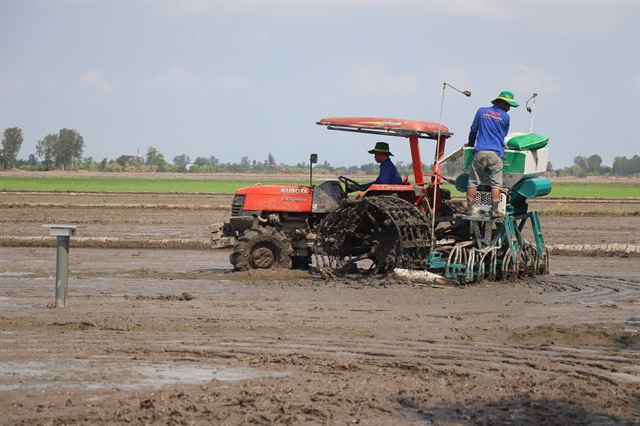 Society
Society


|
| Farmers working on a high-quality, low-carbon rice farm in Cần Thơ City. — VNA/VNS Photo Trần Thị Thu Hiền |
HÀ NỘI — The Fertilize Right Project will provide technical support and training to rice farmers and institutions in six selected provinces to enhance livelihoods, promote food security, improve soil health, and foster a green and climate-resilient economy.
That was the remark by Marc Knapper, US Ambassador to Việt Nam, at the launching workshop on the Fertilize Right Project on Tuesday.
The ambassador said the four-year project, which is part of the US Department of State's Global Fertilizer Challenge, will be implemented across Brazil, Colombia, Pakistan and Việt Nam.
It focuses on the principles of nutrient management and is encapsulated in the four R's: right source, right rate, right time and right place.
Hoàng Trung, Deputy Minister of Agriculture and Rural Development, underlined the efforts Việt Nam had made to accomplish two UN sustainable development goals - responsible production and consumption, and climate action.
He took the Strategic Plan for Sustainable Agriculture and Rural Development between 2021 and 2030 as an example, which was enacted on January 28, 2022, to raise farmers' income, foster environment-friendly practices and minimise greenhouse gas emissions.
The ministry proceeded with the Organic Fertiliser Development and Application Plan in late 2023. The aim is to unlock the potential of organic sources in fertiliser production, thereby achieving a balanced nutrient cycle and enhancing soil health.
With its recent plan to develop one million hectares of high-quality, low-carbon rice, the Ministry set its sights on building a rice value chain that aims to reduce greenhouse gas emissions while improving production efficiency.
Vũ Thắng, Deputy Head of the Fertiliser Management Division under the Ministry's Plant Protection Department, said the number of certified fertiliser products had reached 25,921 by December 2023, of which inorganic fertilisers account for 73.1 per cent; organic fertilisers, 25.3 per cent; and bio-fertilisers, 1.6 per cent.
"Organic fertilisers have soared in quantity over the past five year," said Thắng.
The number of certified fertiliser plants stood at 776 by the date, including 518 facilities producing organic and bio products. Their total capacity amount to 20.6 million tonnes.
Harold Tarver, International Agricultural Development Specialist at the US Department of Agriculture (USDA), said the budget for the Fertilize Right Project in Việt Nam is roughly US$4.4 million, funded by the US Department of State.
The project will work on effective and efficient fertiliser use practices and alternatives to traditional manufactured fertilisers to improve soil health and fertility.
Katelyn Hickey, International Program Specialist at USDA, cited technology and tool development as a component of the project, which includes soil-based nutrient management databases and mobile applications to integrate nutrient maps.
Another component is capacity building and communications, which includes hands-on training and demonstrations as well as establishing a network to share knowledge and best practices.
The last component involves monitoring and evaluating the activities to ensure the objectives are met.
Nguyễn Văn Hùng, Lead of the Fertilize Right Project in Việt Nam, said the agriculture sector produces 90 million CO2-equivalent tonnes of greenhouse gas annually, of which 75 per cent comes from fertiliser production. — VNS